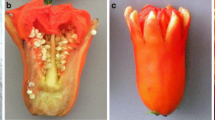Abstract
The present paper deals with the possibility of using growth regulators for the physiological emasculation of rye flowers and utilizes our knowledge of the higher sensibility of stamens to the auxin level. By means of bioassays it has been found that a relatively low content of auxins and a definite level of gibberellins and inhibitors are characteristic for normal rye spikes at the time of stamen differentiation. The higher level of auxins and expressive inhibitions occur in the later course of pistil differentiation.
Two sprayings of plants with mixed solutions of MH and NAA and two further sprayings with a solution of NAA only before the stamen differentiation change slightly the natural character of endogenous regulators in spikes and cause the destruction of mother pollen cells in anthers and the sterility of anthers in the majority of rye florets. The anthers in the basis of spikes sometimes contain pollen grains after treatment, but their fertility is substantially lowered because the spray evidently disturbed the accumulation of reserve substances in pollen grains. The development of pistil was not affected by the exogenous application of growth regulators. Normal kernels arose in the majority of flowers after supplementary pollination. Some accidental effects of exogenous application of growth regulators, as for example reduced stem growth and disorder of lodicule function were lowered to a great extent by adding GAS to the last two sprayings of NAA.
Abstract
Píedložená práce sleduje možnosti použití rustových regulátorů pro fyziologickou kaatraci květů aita a využívá poznatků o vyšší oitlivosti tyčinek látkám auxinové povahy. Biologickými testy bylo zjištěno, že v klasech žita je běbem difereneiace tyčinek poměrné nízký obsah látek auxinové povahy a určitá hladina látek giberelinových a inhibiěních. Během pozdějši diferenciace pestíků doohází zvysení obsahu látek auxinovo povahy vyskytu výrazných inhibic. Dva postřiky rostlin MH s NAA a další dva samotným roztokem NAA během vývoje tyčinek, pozméní poněkud přirozenč Charakter regulátorů a vyvolají sterilitu prašníku ve větsině kvítků. Praáníky na bázi klasu obsahují nékdy pyl, ale jeho fertilitá je podstatně suízena, neboí postřik zřejmě naruší ukládání zásobních látek v pylových zrnech. Vývoj pestíku nebyl exogenní aplikaoí růstových regulátorů ovlivněn. Po dodatecném opylení vznikly vo většině kvitků obilky. Některé vedlejší ůčinky exogenní aplikaoe růstových regulátorů, jako snízeny růst a porucha funkce lodikul, byly do značné míry sníženy pridáním giberelové kyseliny do dvou postriků NAA.
Similar content being viewed by others
References
Bentley, J. A., Housley, S.: Bio-assay of plant growth hormones. — Physiol. Plant.7: 405–419, 1954.
Diakontt, P.: Opredelenije žiznesposobnosti pylcy rastenij. [Estimation of vitality of plant pollen.] — Vest. sel. choz. Nauki8: 123–127, 1962.
Eaton, F. M.: Selective gametocide opens way to hybrid cotton. — Science126: 1174–1175, 1957.
Galun, E.: The role of auxine in the sex expression in the cucumber. — Physiol. Plant.12: 48–60, 1959.
Heslop-Harrison, J.: The control of flower differentiation and sex expression. — Coll. intern. C.N.B.S.123: 649–664, 1964.
Kefford, N. P.: The growth substances separated from plant extracts by chromatography I and II. — J. exp. Bot.6: 129–151, 245-255, 1955.
Moore, J. P.: Male sterility induced in tomato by sodium 2,3-dichlorisobutyrate. — Science129: 1738–1740, 1959.
Moss, G. I., Heslop-Harrison, J.: Photoperiod and pollen sterility in maize. — Ann. Bot.32: 833–846, 1968.
Ná;trová, Z.: Quantitative analysis of free amino acids and carbohydrates in spring barley anthers at different stages of maturity. — Biol. Plant.10: 118–126, 1968.
Nitsch, J. P.: Plant hormones in the development of fruits. — Quart Rev. Biol.27: 33–57, 1952.
Pilet, P. E.: Nouvelle contribution à l’etude du géotropisme des étamines d’Hostacaerulea Tratt. — Bull. Soc. bot. Suisse60: 5–14, 1950.
Salisbury, F. B.: The Flowering Process. — Pergamon, Oxford 1963.
Sembdner, G., Gross, R., Schreiber, K.: Die Dünnschichtchromatographie von Gibberellinen. — Experientia18: 584–585, 1969.
Sladký, Z.: Physiological emasculation of rye flowers by means of exogenous application of growth regulators. — Folia Fac. Sci. Nat. Univ. Purk. Brun. Biol.24: 000–000, 1970.
Teltsoherova, L.: Changes in the level of endogenous gibberellins and auxins in apical buds ofChenopodium rubrum L. after application of growth substances reversing the effect of (2-chlorethyl)-trimethylamonium chloride (CCC) on flowering. — Biol. Plant.10: 305–310, 1968.
Author information
Authors and Affiliations
Rights and permissions
About this article
Cite this article
Sladký, Z. The application of growth regulators for the physiological emasculation of rye(secale cereale l.) flowers. Biol Plant 12, 388–394 (1970). https://doi.org/10.1007/BF02922301
Received:
Published:
Issue Date:
DOI: https://doi.org/10.1007/BF02922301




